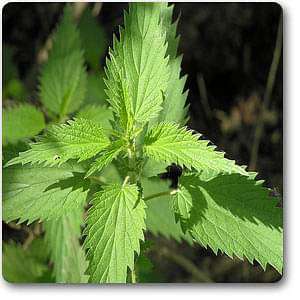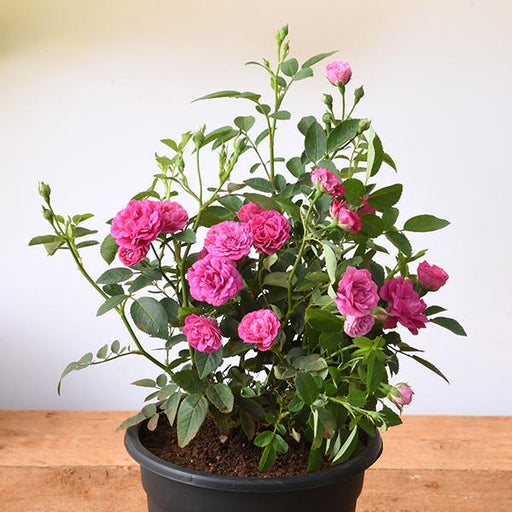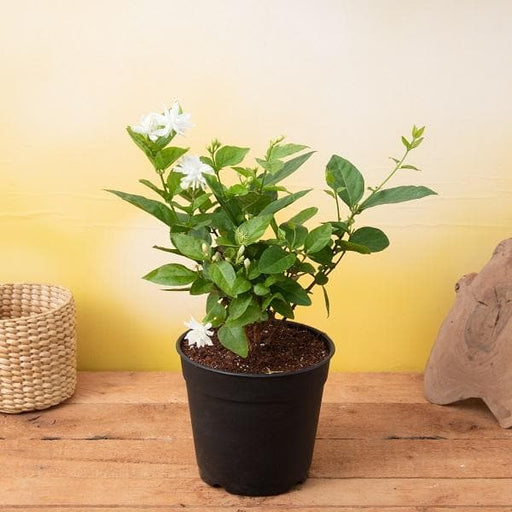
Stinging Nettles - Plant
(MRP Inclusive of all taxes)
- Shipping ₹79 for entire order
- Dispatch in 7 days
- Country of origin: India

(MRP Inclusive of all taxes)
 Save 29%
Save 29%
Air Purifier Money Plant with Pot The Air Purifier Money Plant, also known as Pothos or Epipremnum aureum, is a stunning indoor plant that...
View full details
 Save up to 15%
Save up to 15%
Peace Lily, Spathiphyllum - Plant The Peace Lily, scientifically known as Spathiphyllum, is a stunning houseplant celebrated for its elegant white...
View full details
 Save 25%
Save 25%
Jasminum sambac, Mogra, Arabian Jasmine - Plant Jasminum sambac, commonly known as Mogra or Arabian Jasmine, is a fragrant flowering plant...
View full details
 Save 18%
Save 18%
Combo Constituents Includes the Parijat Tree (Night-Flowering Jasmine), a culturally significant plant with fragrant flowers. Description The Pari...
View full details
 Save 25%
Save 25%
Miniature Rose, Button Rose (Any Color) - Plant The Miniature Rose, also known as the Button Rose, is a charming and compact flowering plant that ...
View full details Save 25%
Save 25%
Damascus Rose, Scented Rose (Any Color) - Plant The Damascus Rose, also known as Rosa damascena, is a timeless symbol of beauty and romanc...
View full details
 Save 17%
Save 17%
Beautiful Fragrant Mogra, Arabian Jasmine Plant with Pot The Beautiful Fragrant Mogra, also known as Arabian Jasmine (Jasminum sambac), is...
View full details Save 15%
Save 15%
Pack of Vermicompost and Neem Cake for House Plants Transform your indoor garden with our premium Pack of Vermicompost and Neem Cake, spec...
View full details
Pack of Plant Growth and Flower Boosters Unlock the full potential of your garden with our Pack of Plant Growth and Flower Boosters! This ...
View full details Save 38%
Save 38%
Combo of Jeevamrut and Neem Raksha for Easy Growth and Protection of Houseplants Transform your indoor garden with our exclusive combo of ...
View full details Save 22%
Save 22%
Plant Nutrients Kit (Pack of 16) for a Healthy Garden Transform your garden into a lush paradise with our Plant Nutrients Kit, featuring 1...
View full details Save 16%
Save 16%
Combo of Top Plant Fertilizers Elevate your gardening game with our exclusive Combo of Top Plant Fertilizers, featuring two bags of premiu...
View full details Save 24%
Save 24%
Pack of 4 Additives to Make Soil Healthy and Nutrient Rich Transform your garden into a thriving ecosystem with our Pack of 4 Additives de...
View full details Save 30%
Save 30%
Transform your gardening experience with our premium Combo of Perlite and Vermiculite. This unique blend is designed to enhance soil aeration and ...
View full details Save 27%
Save 27%
Combo of 2 Vermicompost and Cocopeat - Enrich Your Soil Naturally! Transform your garden into a thriving ecosystem with our Combo of 2 Ver...
View full details
 Save 35%
Save 35%
Best 6 Plants for Perfect Indoor Garden Transform your living space into a lush oasis with our curated collection of the Best 6 Plants for a...
View full details
 Save up to 50%
Save up to 50%
Mini Succulent Garden Pack Transform your space with our Mini Succulent Garden Pack, featuring a delightful collection of 4 any variety beautiful s...
View full details
 Save 30%
Save 30%
5 Best Fragrant Plants Transform your garden or indoor space into a fragrant paradise with our curated selection of the 5 Best Fragrant Plants. Th...
View full details
 Save 24%
Save 24%
Set of 2 Bonsai Looking Grafted Adeniums Transform your indoor or outdoor space with our exquisite Set of 2 Bonsai Looking Grafted Adenium...
View full details Save 45%
Save 45%
Top 4 Die Hard Succulents Pack Transform your indoor or outdoor space with our Top 4 Die Hard Succulents Pack, featuring a curated selecti...
View full details
 Save 30%
Save 30%
5 Best Indoor Plants Pack Transform your living space into a lush oasis with our '5 Best Indoor Plants Pack.' This carefully curated collection fe...
View full details
 Save 25%
Save 25%
Set of 4 Evergreen Air Purifier Plant Pack Transform your indoor space into a lush, green oasis with our Set of 4 Evergreen Air Purifier Pla...
View full details| SrNo | Item Name |
|---|---|
| 1 | Stinging Nettles - Plant |
Stinging Nettles (Urtica dioica) are perennial plants known for their unique stinging hairs that can cause a temporary burning sensation upon contact. These hardy plants thrive in a variety of environments, from rich woodlands to disturbed areas, and are often found in temperate regions worldwide. Beyond their notorious sting, nettles are packed with nutrients, making them a valuable addition to any garden or herbal remedy collection.
What makes Stinging Nettles special is their rich nutritional profile, containing vitamins A, C, K, and several B vitamins, along with minerals like iron, calcium, and magnesium. Historically, they have been used for centuries in traditional medicine and as a food source, showcasing their versatility and importance in various cultures.
One of the standout features of Stinging Nettles is their ability to improve soil health. They are known to attract beneficial insects and can be used as a natural fertilizer when composted, enriching the soil with nutrients. Additionally, their leaves can be harvested for culinary uses, making them a sustainable choice for eco-conscious gardeners.
Stinging Nettles play a crucial role in their ecosystems by providing habitat and food for various wildlife species. Their ability to improve soil health and attract beneficial insects makes them an excellent choice for sustainable gardening practices.
Stinging nettles are like the overachievers of the plant world. They’re packed with vitamins A, C, K, and a buffet of minerals. Think of them as nature’s multivitamin, but without the chalky aftertaste. These little green powerhouses can help with everything from reducing inflammation to boosting your immune system. Plus, they’re a fantastic source of iron, making them a favorite among those who want to channel their inner Popeye. So, if you’re looking to add a little zing to your health routine, consider inviting stinging nettles to the party. Just remember, they might sting a bit if you’re not careful!
If you think tea is just for fancy afternoon gatherings, think again! Stinging nettles tea is the rebellious cousin of your typical Earl Grey. Brewed from the leaves of the stinging nettle plant, this herbal infusion is a delightful way to sip on health benefits. It’s like a warm hug for your insides, helping with allergies, detoxification, and even joint pain. Plus, it’s caffeine-free, so you can enjoy it any time of day without the jitters. Just be sure to steep it long enough to unleash all those magical properties. Who knew a plant that stings could also soothe?
Move over, spinach! Stinging nettles are here to steal the culinary spotlight. These leafy greens can be sautéed, blended into soups, or even tossed into pasta dishes for a nutritious twist. When cooked, they lose their sting and transform into a deliciously earthy flavor that adds depth to any meal. Think of them as the secret ingredient that will make your friends wonder if you’ve been taking gourmet cooking classes. So, don’t shy away from these prickly pals; embrace them in your kitchen and watch your dishes go from drab to fab!
Who knew that a plant known for its sting could also be a skincare superstar? Stinging nettles are packed with antioxidants and anti-inflammatory properties, making them a fantastic addition to your beauty routine. They can help soothe irritated skin, reduce redness, and even combat acne. It’s like having a tiny herbal spa treatment right in your garden! Just be sure to use them in a tincture or infused oil, and you’ll be on your way to glowing skin that’s the envy of all your friends. Who needs expensive creams when you have nature’s own remedy?
If you’re looking to give your garden a boost, stinging nettles are the unsung heroes of the compost pile. Packed with nitrogen, they make an excellent fertilizer that can help your plants thrive. Just steep them in water for a few weeks, and voilà! You’ve got a nutrient-rich liquid gold that will have your garden singing with joy. It’s like giving your plants a protein shake, but without the blender cleanup. So, don’t toss those nettles aside; they’re the secret sauce your garden has been craving!
Allergies got you down? Stinging nettles might just be the natural remedy you’ve been searching for. These feisty plants have antihistamine properties that can help alleviate sneezing, itching, and all those other pesky allergy symptoms. It’s like having a tiny army of herbal warriors fighting off pollen and dust for you. You can brew them into tea or take them in supplement form, and soon you’ll be breathing easy and enjoying the great outdoors again. Who knew that a plant that stings could also be your best friend during allergy season?
Stinging nettles have been the go-to herbal remedy for centuries, and for good reason! They’re like the Swiss Army knife of the plant world, offering a plethora of health benefits. From treating arthritis to supporting urinary health, these little green wonders have a reputation that precedes them. Herbalists have long praised their ability to promote overall wellness, making them a staple in natural medicine cabinets. So, if you’re looking to tap into the wisdom of ancient herbal practices, stinging nettles are a must-have. Just remember to handle them with care—no one wants a surprise sting during their healing journey!
Want luscious locks that turn heads? Stinging nettles might just be your new best friend. Packed with vitamins and minerals, they can promote hair growth and improve scalp health. Think of them as a natural hair tonic that nourishes from the roots up. You can infuse them into oils or use nettle tea as a rinse, and soon you’ll be flaunting hair so shiny and healthy that it could rival a shampoo commercial. So, ditch the chemical-laden products and embrace the power of stinging nettles for hair that’s as fierce as you are!
Stinging nettles have been the go-to remedy in traditional medicine for ages, proving that sometimes, the old ways are the best ways. Used in various cultures for their anti-inflammatory and diuretic properties, these plants have earned their place in the herbal hall of fame. From ancient Greece to modern-day herbalists, stinging nettles have been celebrated for their ability to support overall health. So, if you’re looking to channel your inner herbalist, don’t overlook these prickly plants. They’ve got a wealth of wisdom to share, and they’re ready to help you on your wellness journey!
Yes, you read that right! Stinging nettles can be beneficial for your furry friends too. Packed with nutrients, they can help with allergies, joint pain, and even digestive issues in pets. Just be sure to consult your vet before introducing them to your pet’s diet. When prepared correctly, stinging nettles can be a great addition to your pet’s meals, giving them a health boost that will have them wagging their tails in delight. Who knew that a plant that stings could also be a pet’s best friend?
If you’re a gardener looking to spice things up, stinging nettles are the perfect addition to your green thumb repertoire. Not only do they attract beneficial insects, but they also serve as a natural pest deterrent. Plus, they can be used to create nutrient-rich compost or fertilizer, giving your plants the boost they need to thrive. Just be prepared for a little sting if you’re not careful! Embrace the wild side of gardening with stinging nettles, and watch your garden flourish like never before.
Stinging nettles are those cheeky green plants that pack a punch! Known scientifically as Urtica dioica, they’re infamous for their tiny, hair-like structures that deliver a sting when touched. But don’t let that scare you; they’re also packed with nutrients and have been used in cooking and herbal medicine for centuries.
A burning sensation and redness that can last for hours.
Absolutely! Stinging nettles are the culinary underdogs of the plant world. Once cooked or dried, their sting disappears, revealing a delicious, nutritious green. They’re rich in vitamins A, C, and K, making them a superfood. Toss them in soups, teas, or pesto, and you’ll be the coolest chef on the block!
Harvesting stinging nettles is like a game of tag—just be quick and careful! Wear gloves to protect your hands, and snip the young leaves and tops in spring. The younger the leaves, the tastier they are. Just remember, the goal is to collect, not to get stung!
Yes, indeed! Stinging nettle tea is a delightful way to enjoy this plant without the sting. Simply steep dried leaves in hot water, and voilà! You’ve got a herbal infusion that’s not only tasty but also brimming with health benefits. Sip away and feel like a wellness guru!
Cooking stinging nettles is a breeze! Just blanch them in boiling water for a minute to neutralize the sting, then toss them into your favorite dishes. They can be sautéed, added to soups, or blended into smoothies. Get creative, and let your culinary imagination run wild!
While stinging nettles are generally safe, they can cause allergic reactions in some folks. If you’re on blood thinners or have certain health conditions, consult your doctor before diving into the nettle feast. Remember, even nature’s wonders can have a mischievous side!
Stinging nettles are the ultimate overachievers, thriving in a variety of environments. You’ll find them in damp, nutrient-rich soils, often near rivers, forests, and even in your backyard. They love to party in the wild, so keep an eye out for their vibrant green presence!
Absolutely! Stinging nettles make a fantastic organic fertilizer. Just steep the leaves in water for a few weeks, and you’ll create a nutrient-rich liquid fertilizer that plants adore. It’s like giving your garden a green smoothie—healthy and revitalizing!
Drying stinging nettles is as easy as pie! Simply gather the leaves, spread them out in a single layer, and let them air dry in a cool, dark place. Once they’re crispy, store them in an airtight container. You’ll have a stash of nettles ready for tea or cooking!
Yes, they can! Stinging nettles have natural antihistamine properties that may help alleviate allergy symptoms. They’re like a gentle friend who brings you tissues during allergy season. Just remember to consult with a healthcare professional before using them as a remedy.